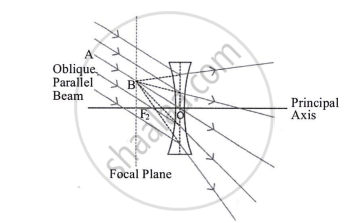Advertisements
Advertisements
प्रश्न
A parallel, oblique beam of light falls on a concave lens. Draw a diagram to show refraction of light through the lens.
उत्तर

The concave lens in the accompanying diagram is refracting a parallel, oblique beam of light.
APPEARS IN
संबंधित प्रश्न
Explain with the help of a diagram, why the concave lens is also called a diverging lens.
List some things that concave lens and concave mirror have in common.
A converging lens is used to produce an image of an object on a screen,object on a screen. What change is needed for the image to be formed nearer to the lens?
(a) increase the focal length of the lens
(b) insert a diverging lens between the lens and the screen
(c) increase the distance of the object from the lens
(d) move the object closer to the lens
Which type of lenses are:
thinner in the middle than at the edges?
Give the position, size and nature of image of formed by a concave lens when the object is placed:
anywhere between optical centre and infinity.
A concave lens has focal length 15 cm. At what distance should the object from the lens be placed so that it forms an image at 10 cm from the lens? Also find the magnification produced by the lens.
If the image formed by a lens is diminished in size and erect, for all positions of the object, what type of lens is it?
A student obtained clear image of window grills on the screen. But the teacher told him to get the image of a tree far away, instead of window. To get a clear image, the lens must be ............................
An object is placed at a distance of 60 cm from a concave lens of focal length 30 cm.
(i) Use the lens formula to find the distance of the image from the lens.
(ii) List four characteristics of the image (nature, position, size, erect/inverted) formed by the lens in this case.
(iii) Draw a ray diagram to justify your answer of the part (ii).
Convex magnifying glass is called divergent magnifying glass and concave magnifying glass is called converging magnifying glass.
